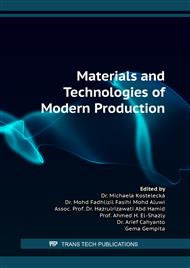[1]
Aslam A, Khan DA, Hassan SH, Ahmed B. Ceramic fracture in metal-ceramic restorations: The aetiology. Dent Update 2017;44(5):448–56.
DOI: 10.12968/denu.2017.44.5.448
Google Scholar
[2]
Chihargo, Tamin HZ. Role of coping designs against fracture resistance of porcelain in metal-porcelain fixed partial denture: A review. EPRA Int J of Multidisc Res 2017;3(6):44-9.
DOI: 10.4103/jioh.jioh_5_19
Google Scholar
[3]
Gladwin BM. Clinical Aspects of Dental Materials. 4th ed. USA: Lippincott Williams & Wilkins;2013.pp.93-100.
Google Scholar
[4]
Yoon JW, Kim SH, Lee JB, Han JS, Yang JH. A study on the fracture strength of collarless metal-ceramic fixed partial dentures. J Adv Prosthodont 2010;2(4):134-41.
DOI: 10.4047/jap.2010.2.4.134
Google Scholar
[5]
Bulbule N, Motwani BK. Comparative study of fracture resistance of porcelain in metal ceramic restorations by using different metal coping designs- An in vitro study. J Clin Diagn Res. 2014;8(11):123-7.
DOI: 10.7860/jcdr/2014/10336.5203
Google Scholar
[6]
Afroz S, Chand P. Collarless metal ceramic restorations to obscure the umbrella effect. Indian J Dent Res 2010;21(4):600-2.
DOI: 10.4103/0970-9290.74228
Google Scholar
[7]
Chihargo, Tamin HZ, Nasution I. The influence of coping designs on labio-marginal towards fracture resistance of metal-porcelain restoration. J Int Oral Heal 2019;11(2):80-5.
DOI: 10.4103/jioh.jioh_5_19
Google Scholar
[8]
Vernekar NV, Jagadish PK, Diwakar S, Nadgir R, Krishnarao MR. Alternate metal framework designs for the metal ceramic prosthesis to enhance the esthetics. J Adv Prosthodont.2011;3(3):113-8.
DOI: 10.4047/jap.2011.3.3.113
Google Scholar
[9]
Chatterjee U. Margin designs for esthetic restoration: An overview. J Adv Oral Research 2012;3(1):7-10.
Google Scholar
[10]
Craig R, Powers J. Restorative Dental Materials. 11th ed. St.Louis: Mosby; 2002. pp.342-344.
Google Scholar
[11]
Dental alloys and consumables. Product catalog global markets. 2020. Accessed 5 Februari 2020. URL: https://www.ivoclarvivadent.com/en/p/all/products/alloys/predominantly-base-alloys/nickel-chromium/4all.
Google Scholar
[12]
Craig, RG, Power, JM, Watana, JC. Restorative Dental Material. 10th ed. St. Louis: Mosby; 2000. p.269.
Google Scholar
[13]
Manual framework design for metal-ceramic restorations. Accessed 2 Desember 2020. https://www.ivoclarvivadent.in/en-in/p/all/products/metal-ceramics/ips-classic.
Google Scholar
[14]
Gardner FM, Tillman-mccombs MKW, Max L, Runyan DA, College M. In vitro failure load of metal-collar margins compared with porcelain facial margins of metal-ceramic crowns. J Prosthet Dent 1997;78(1):1-3.
DOI: 10.1016/s0022-3913(97)70079-9
Google Scholar
[15]
Swati S, Chowdhary R, Patil PS. Marginal strength of collarless metal ceramic crown. Int J Dent 2010; 10(6):1-4.
DOI: 10.1155/2010/521470
Google Scholar
[16]
IPS Classic. Scientific documentation. Juli 2003. Accessed 5 Februari 2020. https://www.ivoclarvivadent.in/en-in/p/all/products/metal-ceramics/ipsclassic.
Google Scholar
[17]
Framework design for metal-ceramic restorations. Manual. Accessed 5 Februari 2020. https://www.ivoclarvivadent.com/zoolu-website/media/document/570/Metal-Ceramic+Framework+Design+Manual.
Google Scholar
[18]
Shokry TE, Attia M, Mosleh, Elhosary M, Hamza T, Shen C, Effect of metal selection and porcelain firing on the marginal accuracy of titanium-based metal ceramic restorations. J Prosthet Dent 2010;103(1):45-52.
DOI: 10.1016/s0022-3913(09)60216-x
Google Scholar
[19]
Annusavice KJ, Shen C, Rawls HR. Philip's Science of Dental Material. 12th ed. Philadephia: Elsevier, 2012. p.383, 429-45.
Google Scholar
[20]
O'Brien WJ. Textbook of dental material and their selection. 3rd ed. Chicago: Quintessenc; 2012. pp.345-81.
Google Scholar
[21]
Bergmann CP, Stumpf A. Dental Ceramics: Microstructure, Properties and Degradation. New York: Springer; 2013. P.17-20.
Google Scholar
[22]
O'Boyle KH, Norling BK, Cagna DR, Phoenix RD. An investigation of new metal framework design for metal ceramic restorations. J Prosthet Dent 1997; 78(3):295-301.
DOI: 10.1016/s0022-3913(97)70029-5
Google Scholar
[23]
Ku CW, Park SW, Yang HS. Comparison of the fracture strengths of metal-ceramic crowns and three ceromer crowns. J Prosthet Dent 2002;88(2):170-5.
DOI: 10.1067/mpr.2002.127712
Google Scholar
[24]
Zaki M, Shobber A, Alkhadra TA. Fracture resistance of different primary anterior esthetic crowns. Saudi Dent J 2017;29(4):179-84.
DOI: 10.1016/j.sdentj.2017.07.006
Google Scholar
[25]
Vojdani M, Torabi K, Farjood E KA. Comparison the marginal and internal fit of metal copings cast from wax patterns fabricated by CAD/CAM and conventional wax up techniques. J Dent (Shiraz) 2013;14(3):118-29.
DOI: 10.22271/oral.2021.v7.i3e.1319
Google Scholar
[26]
Savencu CE, Șerban, C, Porojan L. Adaptability evaluation of metal-ceramic crowns obtained by additive and subtractive technologies. Appl Sci 2020;10(16):1-11.
DOI: 10.3390/app10165563
Google Scholar
[27]
Witkowski S, Komine F GT. Marginal accuracy of titanium copings fabricated by casting and CAD/CAM techniques. J Prosthet Dent 2006;96(1): 47-52.
DOI: 10.1016/j.prosdent.2006.05.013
Google Scholar
[28]
Stangel I, Nathanson D HC. Shear strength of the composite bond to etched porcelain. J Dent Res 1987; 66(9):1460-5.
DOI: 10.1177/00220345870660091001
Google Scholar
[29]
Tuntiprawon M WP. The effect of cement thickness on the fracture strength of all-ceramic crowns. Aust Dent J 1995;40(1):17-21.
DOI: 10.1111/j.1834-7819.1995.tb05607.x
Google Scholar
[30]
Rossenstiel SF, Land MF, Fujimoto J. Contemporary fixed prosthodontics, metal ceramic restorations. 4th ed. Missouri: Mosby; 2006. pp.761-7.
Google Scholar
[31]
Rao S CR. Comparison of fracture toughness of all-ceramic and metal–ceramic cement retained implant crowns: an in vitro study. J Indian Prosth Soc 2014;14(4):408-14.
DOI: 10.1007/s13191-013-0347-6
Google Scholar



